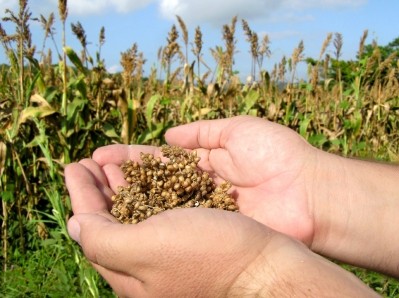USDA: Soybeans, corn, wheat exports to improve while feed stays flat in 2017

Details of the predictions for international exports from the US in fiscal 2017 were released last week in a new Outlook for US Agricultural Trade report from the USDA’s Economic Research Service (ERS).
Total agricultural exports are set at $133bn, an improvement from the revised forecast for fiscal year 2016 of $127bn, said the department. Imports are expected to be about $113.5bn, an increase of about $400m from fiscal 2016.
The increased exports stem are based on anticipated sales of oilseeds and products, livestock, dairy, poultry, horticultural products and cotton, said the department.
“Record 2016/17 US soybean yields and production will ensure ample supplies for export and crush while minimizing price gains,” said the USDA. “Soybean export value is forecast to rise $2.2bn to $21.2bn, while soybean meal is projected $400m higher at $4.4bn.”
Globally, per capita GDP is expected to grow by 1.2% in 2016, which matches 2015, said the USDA. And, the US had a per capital GDP growth of about 1.3% in 2016, not matching 2015 developments. Both are expected to improve for 2017.
Feed grains and soy
For fiscal year 2017 grain and feed exports are expected to be about $29.3bn – the same as 2016 estimates, said the USDA. A decline in sorghum exports should be matched by an increasing wheat and corn exports.
Wheat exports in 2017 are predicted to improve by $100m to $5.1bn and gain market share in the Western Hemisphere, said the US agency.
Overall coarse grain exports are set at 10.5bn, a drop of $200m from 2016, said the USDA. “Sorghum is lowered $600m to $1bn due to lower unit values and volumes, based on expectations of reduced demand from China,” it added.
Corn exports in 2017 are raised by $500m to about $9.4bn, based on volume, competitive prices and a drop in competition from Brazil, the department said. “Exports for feed and other products are expected to be steady,” it added.
However, the overall estimate for grain and feed exports in 2016 did see an increase of $1.6bn, based on coarse grain and products, the department said. Sales and shipments for corn, sorghum, feeds and fodders have improved since the May forecast.
Feed and products including distillers’ dried grains with solubles have increased slightly based on sales to China, said the department.
Export for fiscal 2017 of oilseeds and products has been raised by $2.7bn to $31bn stemming from record soybean export volumes and unit values, said the USDA. “Increased unit values are in response to a tight supply situation in South America coupled with continued strong demand for soybeans and soybean meal,” it added.
Oilseeds also saw an increase in the 2016 export forecast based on the reduced availability in Brazil improving soybean and soybean meal volumes higher, said the department.
Export destinations
Additionally, total exports to China are predicted to improve by $3.5bn from what they were in fiscal 2016, said the US agency. The increase would return China to the US’s top export market, replacing Canada, which filled the role in 2016.
“In fiscal year 2017, the forecast for exports to China is $21.5bn, which is $3.5bn higher than the fiscal 2016 forecast, edging out Canada as the largest US market,” said the USDA. “Soybeans account for 55-60% of US exports to China, and export values of soybeans are expected to increase in fiscal 2017 based on higher soybean volume and moderately higher prices. Record US soybean production and tight supplies in South America are expected to boost US competitiveness and increase market share in China.”
Japan, Southeast Asia, Mexico and Canada also are set to see improved intake of soybeans and soybean meal, the department said. And, exports of soybeans, feed and fodder were improved for 2016 to Indonesia.
“In fiscal year 2017, exports to the EU are forecast at $11.8bn, up $300mn from fiscal 2016, on the strength of higher export values of soybeans, soybean meal, and horticultural products such as tree nuts,” said the department.
Import numbers
Import amounts are expected to grow for products including horticultural and tropical items and drop in livestock, dairy and poultry products, said the USDA. “The US agricultural trade surplus is expected to increase by $5.6bn in fiscal 2017 to $19.5bn,” it added.
In 2016 imports have dropped about $1.7bn from earlier estimates based on a reduction of imports of several items including oilseeds and products, the department said. “Fiscal year 2016 imports of oilseeds and products are reduced $500m from the previous forecast to $8.3bn, and fiscal year 2017 imports are expected to fall an additional $200m,” it added.
Grain and feed imports in 2017 are predicted to be about $10.8bn, of drop of $100m from fiscal year 2015 and expected 2016 amounts, the department said. The change is based on domestic production of wheat and coarse grains.
Economic outlook
Emerging markets including Brazil, Russia, India, Indonesia and China are predicted to see a 3.5% per capita income growth for 2016 and increase to 4.2% next year, the department said. The rate remains behind what those countries saw in the past decade.
“Global trade volume is expected to grow at only 1.1 percent in 2016, but to more than double to 2.6 percent in 2017,” said the USDA.
The UK pound had potentially the most significant currency change for the quarter, and the dollar appreciated against both the pound and the euro after the UK’s vote to leave the EU, said the department. “While the result of the vote initially stunned markets, it appears that the longer term economic consequences will largely be confined to the UK,” it added.












